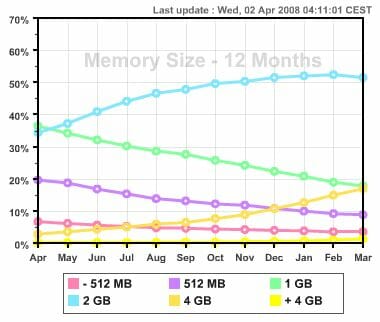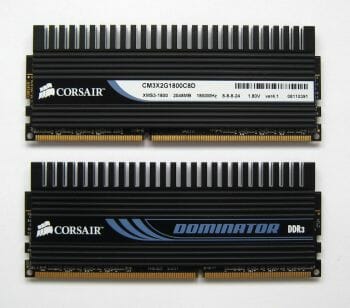First Look at Corsair Dominator TW3X4G1800C8DF G: 4GB DDR3-1800 SDRAM

Corsair Company brings the 2 x 2GB DDR3 memory kits to a new level offering a 4GB kit that doesn’t yield to any of the existing 2GB kits in specifications. We got a chance to check out this promising solution in our labs, so read the details in our first look article!
The launch and wide spreading of the new Windows Vista operating system inspired a lot of users to think about installing 4GB of RAM into their systems. True, it would be not quite right to claim that 2GB of RAM is enough for majority of tasks these days. Even dedicated gaming fans will definitely be able to name a few contemporary gaming titles that won’t work fast enough in systems equipped only with 2GB of memory causing the operating system to address the swap-file and resulting into noticeable delays when loading the next level.
As for the professionals who work with image, sound and video content processing applications, they always lack memory power and are very excited about any possibility to increase the amount of RAM in their systems. In other words, the transition to 4GB of RAM is currently as acute as never before.
This also follows from the statistics collected by the popular CPU-Z diagnostic utility. As you can see from the graph below, systems with 4GB of RAM gained popularity very rapidly starting from last fall. Today the share of systems with 4GB of memory is already more than 18%, which indicates a definite interest shift.

Of course, this tendency touches upon the forefront of computer community in the first place. In other words, an overclocker system equipped with 4GB of RAM is more of a common thing these days than an exception. Nevertheless, we haven’t yet reviewed any system memory kits with 4GB total capacity on our site. There were several reasons for that. First of all, these kits were not very widely spread yet because of their relatively modest frequency and pretty high price point. Therefore, computer enthusiasts preferred to use four 1GB modules instead of two 2GB modules in their systems.
Nevertheless, the situation changed a little now that DDR3 SDRAM is in the market. Typical DDR3 chips are 1Gbit ones, so it is fairly simple to put together double-sided 2GB overclocker memory modules from them. That is why there are quite a few companies who are currently offering overclocker DDR3 SDRAM with the total 4GB capacity.
It is potentially more beneficial to install 2 memory modules 2GB each into the system instead of four 1GB modules. The main advantage in this case is the fact that two DIMM slots remain available allowing future system upgrade up to 8GB of total RAM size. Moreover, we all know that the use of fewer components increases the system reliability.
However, despite this fact, overclockers do not hurry to purchase 4GB memory kits just yet. The thing is that most 2GB DDR3 SDRAM modules available today work at lower nominal frequency than 1GB modules. While the currently available 2GB kits have already hit 1800MHz default speed (and some manufacturers are getting ready to offer 2GHz solutions), the maximum frequency of the available 4GB DDR3 kits is only 1600MHz.
However, Corsair, who have been at the head of the entire overclocker memory maker group for a while now, decided to resolve this situation with 4GB kit frequencies. In the nearest future Corsair will be launching a DDR3 SDRAM kit including two 2GB modules that is designed to work at the default 1800MHz frequency. It will be one of the first DDR3-1800 SDRAM kits to start selling. To be fair I have to point out that the formal pioneer in introducing 4GB kits of DDR3-1800 SDRAM into the market is actually Super Talent. However, we didn’t get a chance to obtain any review samples from them, while Corsair was very eager to let us check out their new 4GB solution even before the official launch, so we are very please to share our test results and findings with you today.
Closer Look
Before we share our first impressions from this memory kit let’s take a closer look at it:

Corsair Dominator TW3X4G1800C8DF G kit consists of two 2GB modules, each marked as CM3X2048-1800C8D. The memory is designed to work at 1800MHz with 8-8-8-24 timings and 1.8V nominal voltage.
I would lie to say right away that the specifications of this kit are not quite common: they are very much different from what a typical 2GB DDR3-1800 SDRAM kits would have to offer. The first thing that catches your eye is their relatively low voltage, which is only 0.3V higher than the voltage according to JEDEC specification. The timings are also not quite standard: typical overclocker DDR3-1800 modules with 1GB capacity usually support slightly better timings settings.
In fact, all this can be very easily explained. While 1GB DDR3 nodules for overclockers were built using Micron chips, Corsair selected Samsung chips for their DDR3-1800 DIMMs of twice the capacity. By the way, these chips have never been used before for overclocker memory modules. However, now that new Gigabit DDR3 chips on D-die appeared, the situation has changed, and Corsair Dominator TW3X4G1800C8DF G is living proof of that.
The different components base, however, didn’t affect the looks of Corsair Dominator TW3X4G1800C8DF G modules. Each memory module in the Dominator series features 51mm tall aluminum heat-spreader with shallow ribs on the front and comb-shaped ribbing at the top. Moreover, these modules use a special PCB with an additional pair of comb-shaped heat-spreaders attached to its top edge. Corsair engineers used this solution to ensure proper dissipation of heat BGA memory chips transfer to the PCB via their pins. So, each Dominator module features four heat-spreaders at the same time: Corsair calls this feature DHX (Dual Heat Exchange).
There are stickers with the company and product logos on the front and back sides of the memory modules as well as stickers with the module specifications, including individual product part number, its nominal clock frequency, capacity and timings.
The nominal specifications of our today’s testing participants look as follows:
| Corsair Dominator TW3X4G1800C8DF G | |
|---|---|
| Kit capacity | 2 modules 2GB each |
| Frequency | 1800 MHz |
| Timings | 8-8-8-24 |
| Voltage | 1.8 V |
| Memory chips | Samsung K4B1G0446D |
| Cooling system | Aluminum DHX heat-spreaders |
Here I would like to add that before getting to you, Corsair Dominator TW3X4G1800C8DF G modules are being tested in-house on ASUS P5E3 Premium based on Intel X48 chipset. However, this kit will certainly operate on a much broader range of mainboards built around Intel and Nvidia chipsets.
Nevertheless, unlike the overclocker DDR3 memory kits we have reviewed before, this one is a double-sided one. That is why it loads the memory controller and may cause certain compatibility issues. For example, these modules will only work in black DIMM slots on ASUS mainboards. On Gigabyte mainboards they will also remain stable only when installed into the DIMM slots located farther from the chipset and processor socket.
Moreover, during our tests we discovered that this kit would not work at its default frequency in certain individual ASUS and Gigabyte mainboard samples. For example, we failed to get this kit to work in ASUS P5E3 Premium sample that we had in our lab at the time of tests. In other words, TW3X4G1800C8DF G kit set very high requirements to mainboard quality and far not all the units actually meet them 100%.
Corsair Dominator TW3X4G1800C8DF G modules support Extreme Memory Profile technology: their SPD contains extended profile with the settings for 1800MHz:
The profile provides the timings settings recommended for these memory modules when running in overclocker mode.
Practical Experiments
To check out the practical performance of our memory kit we put together a special testbed. Since the kit refused to work with the ASUS P5E3 Premium mainboard sample based on Intel X38 chipset we had at our disposal, the testbed was built around ASUS P5K3 Deluxe on Intel P35 that ahs already stood the test of time and has always demonstrated excellent stability during overclocking.
As a result, our testbed was configured as follows:
- CPU: Intel Core 2 Duo E8500 (LGA775, 3.16GHz, 1333MHz FSB, 6MB L2, Wolfdale).
- Mainboard: ASUS P5K3 Deluxe (LGA775, Intel P35, DDR3 SDRAM).
- Graphics card: OCZ GeForce 8800GTX.
- HDD: Western Digital WD1500AHFD.
- PSU: SilverStone SST-ST85ZF (850W).
- OS: Microsoft Windows Vista Ultimate x64.
We overclocked the memory using FSB:Mem divider of 1:2. System stability was tested with Memtest86+ 2.01 and Prime95 25.3.
I would like to point out that since the existing DDr3 memory controllers of Intel P35, Intel X38 and Intel X48 chipsets do not support any FSB:Mem dividers lower than 1:2, you need to overclock the FSB beyond 450MHz in order to clock the memory at 1800MHz. That is why to ensure our overclocker experiments succeed, we reduced the processor clock frequency multiplier from 9.5X to 9x and at the same time increased its Vcore to 1.4V and NB voltage to 1.7V.
The results we obtained during our Corsair Dominator TW3X4G1800C8DF G tests proved up to our expectations. These modules can not only work at 1800MHz, but can also be overclocked to much higher frequencies even without increasing the voltage beyond the nominal 1.8V. By the way, the modules’ reaction to voltage increase beyond the specified 1.8V is slightly different from what we are used to seeing. The thing is that 1GB overclocker memory modules built with Micron chips were pretty sensitive to voltage increase and their overclocking potential went up. Things are different with TW3X4G1800C8DF G: the increase of their voltage past 1.8V hardly affects the result. That is why we first of all tested our memory kit at this particular voltage setting.
Corsair Dominator TW3X4G1800C8DF G overclocked to 1864MHz with default timings of 8-8-8-24 and remained 100% stable.
We obtained this result with Command Rate set at 2T, as stated in the XMP profile. Note that during overclocking to 1864MHz on the memory, when the FSB was set to 466MHz and the CPU frequency was pushed to 4.19GHz, we managed to set the Performance Level parameter to 6. This has definitely affected the performance: the practical read speed made 11GB/s and latency dropped to 47.7ns.
We have also check out how well Corsair Dominator TW3X4G1800C8DF G can overclock with Command rate set to 1T. the maximum frequency when the system remained stable with these settings turned out a little lower, but nevertheless, very pleasing.
The memory could run not only at its nominal speed, but also at a higher 1836MHz frequency. It is interesting that the practical memory subsystem bandwidth in this case turned out even higher than at 1864MHz with 2T Command rate setting: the read speed increased to 11.2GB/s and the latency went down to 46.3ns.
We have also tried overclocking Corsair Dominator TW3X4G1800C8DF G kit in a few other modes. The complete description of the obtained results is given in the table below:
| Corsair Dominator TW3X4G1800C8DF G | ||
|---|---|---|
| Timings | Voltage | Maximum frequency |
| 7-7-7-20 2T | 1.8 V | 1656 MHz |
| 8-7-7-24 2T | 1.8 V | 1780 MHz |
| 8-8-8-24 1T | 1.8 V | 1836 MHz |
| 8-8-8-24 2T | 1.8 V | 1864 MHz |
| 8-8-8-24 2T | 2.1 V | 1868 MHz |
| 9-9-9-24 2T | 2.0 V | 1892 MHz |
As we see, Corsair selected the most optimal combination of parameters for their new solution. By setting the timings to anything other than the default 8-8-8-24 doesn’t allow you to achieve any significantly better overclocking results. Even increasing the voltage beyond 1.8V has no effect. TW3X4G1800C8DF G modules cannot remain stable at 1800MHz with more aggressive timings than the default 8-8-8-24.
So, it turns out that Corsair Dominator TW3X4G1800C8DF G memory kit works perfectly well at frequencies close to the nominal 1800MHz, but cannot be overclocked a lot neither by setting less aggressive timings nor by increasing the operational voltage. From this standpoint it yields a little bit to the existing 2GB DDR3 SDRAM kits built on Micron chips, however, this is hardly a significant drawback taking into account twice the capacity of this kit.
Conclusion
So, thanks to Corsair who have introduced to overclockers Samsung DDR3 memory chips, 4GB memory kits can easily overclock to the same frequencies as the existing 2GB DDR3 SDRAM kits for overclockers. In other words, Corsair Company appeared one of the first makers of overclocker DDR3 SDRAM to launch a two-module DDR3-1800 kit with 4GB total capacity. And it means that those overclockers who wish to equip their systems with 4GB of memory do not have to settle for compromises any more. Corsair Dominator TW3X4G1800C8DF G kit of 2 memory modules 2GB each keeps the other two DIMM slots in your system free and available for future upgrades and ensures that you will not face any possible compatibility and overclocking issues caused by using 4 memory modules at once.
Nevertheless, I have to say that Corsair Dominator TW3X4G1800C8DF G includes double-sided DDR3 SDRAM modules that may, unfortunately, be incompatible with certain mainboards. Also, the price of this solution of around $490 is a little discouraging at first. DDR3 SDRAM prices still remain pretty high, so a lot of users out there still stick with the good old DDR2 SDRAM for that particular reason.
However, as we have shown in our previous articles, DDR3-1800 SDRAM provides better performance during overclocking especially in system equipped with 4GB of RAM. From this prospective, Corsair Dominator TW3X4G1800C8DF G that can run at 1800MHz with 8-8-8-24 timings is an excellent choice for hard-edged overclocking fans hunting for maximum system performance at any rate. Especially since there are no other 4GB memory kits in the market today that could offer similar characteristics, and buying two 2GB DDR3 memory kits with the same parameters may end up being even more expensive.